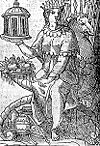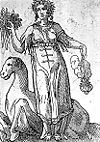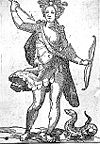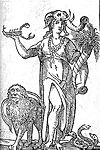
Four continents
Encyclopedia

Continent
A continent is one of several very large landmasses on Earth. They are generally identified by convention rather than any strict criteria, with seven regions commonly regarded as continents—they are : Asia, Africa, North America, South America, Antarctica, Europe, and Australia.Plate tectonics is...
: Africa
Africa
Africa is the world's second largest and second most populous continent, after Asia. At about 30.2 million km² including adjacent islands, it covers 6% of the Earth's total surface area and 20.4% of the total land area...
, America, Asia
Asia
Asia is the world's largest and most populous continent, located primarily in the eastern and northern hemispheres. It covers 8.7% of the Earth's total surface area and with approximately 3.879 billion people, it hosts 60% of the world's current human population...
and Europe
Europe
Europe is, by convention, one of the world's seven continents. Comprising the westernmost peninsula of Eurasia, Europe is generally 'divided' from Asia to its east by the watershed divides of the Ural and Caucasus Mountains, the Ural River, the Caspian and Black Seas, and the waterways connecting...
. Each of the four continents was seen to represent its quadrant of the world—Europe in the north, Asia in the east, Africa in the south, and America in the west. This division fit the Renaissance
Renaissance
The Renaissance was a cultural movement that spanned roughly the 14th to the 17th century, beginning in Italy in the Late Middle Ages and later spreading to the rest of Europe. The term is also used more loosely to refer to the historical era, but since the changes of the Renaissance were not...
sensibilities of the time, which also divided the world into four season
Season
A season is a division of the year, marked by changes in weather, ecology, and hours of daylight.Seasons result from the yearly revolution of the Earth around the Sun and the tilt of the Earth's axis relative to the plane of revolution...
s, four classical element
Classical element
Many philosophies and worldviews have a set of classical elements believed to reflect the simplest essential parts and principles of which anything consists or upon which the constitution and fundamental powers of anything are based. Most frequently, classical elements refer to ancient beliefs...
s, four cardinal directions, four classical virtues, etc.
The four corners of the world refers to the Americas (the "west"), Europe
Europe
Europe is, by convention, one of the world's seven continents. Comprising the westernmost peninsula of Eurasia, Europe is generally 'divided' from Asia to its east by the watershed divides of the Ural and Caucasus Mountains, the Ural River, the Caspian and Black Seas, and the waterways connecting...
(the "north"), Asia
Asia
Asia is the world's largest and most populous continent, located primarily in the eastern and northern hemispheres. It covers 8.7% of the Earth's total surface area and with approximately 3.879 billion people, it hosts 60% of the world's current human population...
/Oceania
Oceania
Oceania is a region centered on the islands of the tropical Pacific Ocean. Conceptions of what constitutes Oceania range from the coral atolls and volcanic islands of the South Pacific to the entire insular region between Asia and the Americas, including Australasia and the Malay Archipelago...
(the "east"), and Africa
Africa
Africa is the world's second largest and second most populous continent, after Asia. At about 30.2 million km² including adjacent islands, it covers 6% of the Earth's total surface area and 20.4% of the total land area...
(the "south").
A three-cornered world
Before the discovery of the New WorldNew World
The New World is one of the names used for the Western Hemisphere, specifically America and sometimes Oceania . The term originated in the late 15th century, when America had been recently discovered by European explorers, expanding the geographical horizon of the people of the European middle...
a commonplace of classical and medieval geography had been the "three parts" in which, from Mediterranean and European perspectives, the world was divided: Europe, Asia and Africa. As Laurent de Premierfait
Laurent de Premierfait
Laurent de Premierfait was a Latin poet, a humanist and in the first rank of French language translators of the fifteenth century, during the time of the mad king Charles VI of France...
, the pre-eminent French translator of Latin literature in the early fifteenth century, informed his readers:
Asia is one of the three parts of the world, which the authors divide in Asia, Africa and Europe. Asia extends towards the OrientOrientThe Orient means "the East." It is a traditional designation for anything that belongs to the Eastern world or the Far East, in relation to Europe. In English it is a metonym that means various parts of Asia.- Derivation :...
as far as the rising sun ("devers le souleil levantLevantThe Levant or ) is the geographic region and culture zone of the "eastern Mediterranean littoral between Anatolia and Egypt" . The Levant includes most of modern Lebanon, Syria, Jordan, Israel, the Palestinian territories, and sometimes parts of Turkey and Iraq, and corresponds roughly to the...
"), towards the south it ends at the great sea, towards the occident it ends at our seaMare NostrumMare Nostrum may refer to:*Mare Nostrum, the Roman term for the Mediterranean Sea, adopted by Italian nationalists and fascists.*Mare Nostrum , a Spanish-language novel by Vicente Blasco Ibáñez...
, and towards the north it ends in the Maeotian marshesMaeotian marshesIn the geography of Antiquity the Maeotian marshes lay where the Don River emptied into the Maeotian Lake near Tanais. The marshes served as a check to the westward migration of nomad peoples from the steppe of Central Asia.The area was named after the Maeotae who lived around the Maeotian Lake....
and the river named ThanausTanaisTanais is the ancient name for the River Don in Russia. Strabo regarded it as the boundary between Europe and Asia.In antiquity, Tanais was also the name of a city in the Don river delta that reaches into the northeasternmost part of the Sea of Azov, which the Greeks called Lake Maeotis...
.

A fourth corner: the enlarged world
For Laurent's French readers, Asia ended at "our sea", the Mediterranean; Europeans were only dimly aware of the Ural MountainsUral Mountains
The Ural Mountains , or simply the Urals, are a mountain range that runs approximately from north to south through western Russia, from the coast of the Arctic Ocean to the Ural River and northwestern Kazakhstan. Their eastern side is usually considered the natural boundary between Europe and Asia...
, which divide Europe from Asia in the eyes of the modern geographer, and which represent the geological suture between two fragmentary continents, or craton
Craton
A craton is an old and stable part of the continental lithosphere. Having often survived cycles of merging and rifting of continents, cratons are generally found in the interiors of tectonic plates. They are characteristically composed of ancient crystalline basement rock, which may be covered by...
s. Instead, the division between these continents in the European-centered picture was the Hellespont, which neatly separated Europe from Asia. From the European perspective, into the Age of Discovery
Age of Discovery
The Age of Discovery, also known as the Age of Exploration and the Great Navigations , was a period in history starting in the early 15th century and continuing into the early 17th century during which Europeans engaged in intensive exploration of the world, establishing direct contacts with...
, Asia began beyond the Hellespont with Asia Minor
Asia Minor
Asia Minor is a geographical location at the westernmost protrusion of Asia, also called Anatolia, and corresponds to the western two thirds of the Asian part of Turkey...
, where the Roman province of Asia had lain, and stretched away to unimaginably exotic and distant places— "the Orient
Orient
The Orient means "the East." It is a traditional designation for anything that belongs to the Eastern world or the Far East, in relation to Europe. In English it is a metonym that means various parts of Asia.- Derivation :...
".
In the sixteenth century America too was full of exotic promise: the "New World
New World
The New World is one of the names used for the Western Hemisphere, specifically America and sometimes Oceania . The term originated in the late 15th century, when America had been recently discovered by European explorers, expanding the geographical horizon of the people of the European middle...
".
In 1603, Cesare Ripa
Cesare Ripa
Cesare Ripa was an Italian aesthetician who worked for Cardinal Anton Maria Salviati as a cook and butler.Little is known about his life. He was born in Perugia and died in Rome. After the death of the cardinal, Ripa worked for his relatives...
published a book of emblems for the use of artists and artisans who might be called upon to depict allegorical figures. He covered an astonishingly wide variety of fields, and his work was reprinted many times. It was still being brought up-to-date in the 18th century. The illustrations reveal fixed Eurocentric perceptions of the nature of the "four corners of the world." Ripa's Europe (illustration, left) is the land of abundance (cornucopia) of kings and the pope, whose crowns and the papal tiara lie at her feet, and of cities.

Bactria
Bactria and also appears in the Zend Avesta as Bukhdi. It is the ancient name of a historical region located between south of the Amu Darya and west of the Indus River...
n coins) and is accompanied by a lion, the scorpion of the desert sands and Cleopatra's asps
Asp (reptile)
Asp is the modern Anglicisation of the word aspis, which in antiquity referred to any one of several venomous snake species found in the Nile region. It is believed that the aspis referred to in Egyptian mythology is the modern Egyptian cobra....
. Asia (illustration, right), the seat of Religion, carries a smoking censer
Censer
Censers are any type of vessels made for burning incense. These vessels vary greatly in size, form, and material of construction. They may consist of simple earthenware bowls or fire pots to intricately carved silver or gold vessels, small table top objects a few centimetres tall to as many as...
as a camel takes its ease.

Indigenous peoples of the Americas
The indigenous peoples of the Americas are the pre-Columbian inhabitants of North and South America, their descendants and other ethnic groups who are identified with those peoples. Indigenous peoples are known in Canada as Aboriginal peoples, and in the United States as Native Americans...
maiden in a feathered headdress, with bow
Bow (weapon)
The bow and arrow is a projectile weapon system that predates recorded history and is common to most cultures.-Description:A bow is a flexible arc that shoots aerodynamic projectiles by means of elastic energy. Essentially, the bow is a form of spring powered by a string or cord...
and arrow. Perhaps she represents a fabled Amazon
Amazons
The Amazons are a nation of all-female warriors in Greek mythology and Classical antiquity. Herodotus placed them in a region bordering Scythia in Sarmatia...
from the river that already carried the name.
The American millionaire philanthropist James Hazen Hyde
James Hazen Hyde
James Hazen Hyde was the son of Henry Baldwin Hyde, the founder of The Equitable Life Assurance Society of the United States. James Hazen Hyde was twenty-three when he inherited the majority shares in the billion-dollar Equitable Life Assurance Society in 1899...
, who inherited a majority share in Equitable Life Assurance Society, formed a collection of allegorical prints illustrating the Four Continents that are now at the New-York Historical Society
New-York Historical Society
The New-York Historical Society is an American history museum and library located in New York City at the corner of 77th Street and Central Park West in Manhattan. Founded in 1804 as New York's first museum, the New-York Historical Society presents exhibitions, public programs and research that...
; Hyde's drawings and a supporting collection of sets of porcelain table ornaments and other decorative arts illustrating the Four Continents were shared by various New York City
New York City
New York is the most populous city in the United States and the center of the New York Metropolitan Area, one of the most populous metropolitan areas in the world. New York exerts a significant impact upon global commerce, finance, media, art, fashion, research, technology, education, and...
museums.

The Four Rivers
Four rivers
Four rivers may refer to:* Four rivers in the Garden of Eden* Four Rivers Bay, Nunavut, Canada* Four Rivers Transportation, an American railroad holding company based in Wilmington, Delaware....
theme appears for example in the Fontana dei Quattro Fiumi
Fontana dei Quattro Fiumi
The Fontana dei Quattro Fiumi or "Fountain of the Four Rivers" is a fountain in Rome, Italy, located in the urban square of the Piazza Navona...
in the Piazza Navona
Piazza Navona
Piazza Navona is a city square in Rome, Italy. It is built on the site of the Stadium of Domitian, built in 1st century AD, and follows the form of the open space of the stadium. The ancient Romans came there to watch the agones , and hence it was known as 'Circus Agonalis'...
in Rome.
With the confirmed discovery that Australia
Australia
Australia , officially the Commonwealth of Australia, is a country in the Southern Hemisphere comprising the mainland of the Australian continent, the island of Tasmania, and numerous smaller islands in the Indian and Pacific Oceans. It is the world's sixth-largest country by total area...
was an island continent, the theme of the "Four Continents" lost much of its drive, long before a sixth continent, Antarctica, was discovered. The iconography survived as the Four Corners of the World, however, generally in self-consciously classicizing contexts: for instance, in New York, in front of the Beaux-Arts Alexander Hamilton U.S. Custom House
Alexander Hamilton U.S. Custom House
The Alexander Hamilton U.S. Custom House is a building in New York City, built 1902–1907 by the federal government to house the duty collection operations for the port of New York. It is located near the southern tip of Manhattan, next to Battery Park, at 1 Bowling Green...
(1907), four sculptural groups by Daniel Chester French
Daniel Chester French
Daniel Chester French was an American sculptor. His best-known work is the sculpture of a seated Abraham Lincoln at the Lincoln Memorial in Washington, D.C.-Life and career:...
symbolize the "Four Corners of the World."

